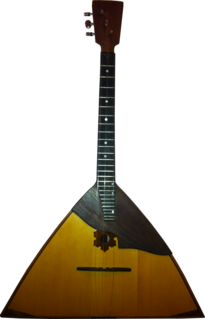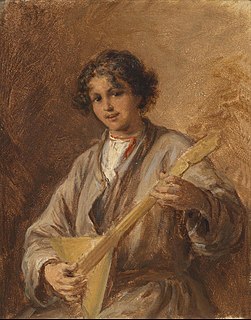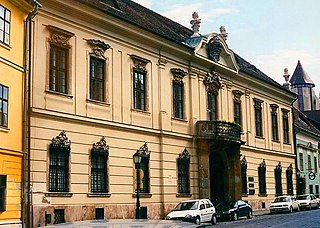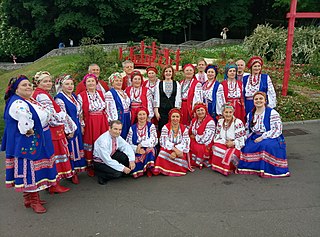
The balalaika is a Russian stringed musical instrument with a characteristic triangular wooden, hollow body, fretted neck and three strings. Two strings are usually tuned to the same note and the third string is a perfect fourth higher. The higher-pitched balalaikas are used to play melodies and chords. The instrument generally has a short sustain, necessitating rapid strumming or plucking when it is used to play melodies. Balalaikas are often used for Russian folk music and dancing.

Music of Russia denotes music produced from Russia and/or by Russians. Russia is a large and culturally diverse country, with many ethnic groups, each with their own locally developed music. Russian music also includes significant contributions from ethnic minorities, who populated the Russian Empire, the Soviet Union and modern-day Russia.
Ukrainian music covers diverse and multiple component elements of the music that is found in the Western and Eastern musical civilization. It also has a very strong indigenous Slavic and Christian uniqueness whose elements were used among many neighboring nations.
Music of Kazakhstan refers to a wide range of musical styles and genres deriving from Kazakhstan. Kazakhstan is home to the Kazakh State Kurmangazy Orchestra of Folk Instruments, the Kazakh State Philharmonic Orchestra, the Kazakh National Opera and the Kazakh State Chamber Orchestra. The folk instrument orchestra was named after Kurmangazy Sagyrbayuly, a well-known composer and dombra player from the 19th century.
Georgia has rich and still vibrant traditional music, which is primarily known as arguably the earliest polyphonic tradition of the Christian world. Situated on the border of Europe and Asia, Georgia is also the home of a variety of urban singing styles with a mixture of native polyphony, Middle Eastern monophony and late European harmonic languages. Georgian performers are well represented in the world's leading opera troupes and concert stages.

A bandura is a Ukrainian, plucked string, folk instrument. It combines elements of the zither and lute and, up until the 1940s, was also often referred to by the term kobza. Early instruments had 5 to 12 strings and similar to the lute. In the 20th century, the number of strings increased initially to 31 strings (1926), then to 56 strings - 68 strings on modern 'concert' instruments (1954).

The zhaleika, also known as bryolka (брёлка), is the Slavic wind instrument, most used in Belarussian, Russian and sometimes Ukrainian ethnic music. Also known as a "folk clarinet" or hornpipe. The zhaleika was eventually incorporated into the balalaika band, the Hungarian tarogato, and may have contributed to the development of the chalumeau, a predecessor of the clarinet.

Stephen M. "Steve" Wolownik was a pioneer in the Russian and Eastern European music community in the United States. He was a co-founder of the Balalaika and Domra Association of America.

The Alexandrov Ensemble is an official army choir of the Russian armed forces. Founded during the Soviet era, the ensemble consists of a male choir, an orchestra, and a dance ensemble.

The domra is a long-necked Belarusian, Russian, and Ukrainian folk string instrument of the lute family with a round body and three or four metal strings.

Music of Northeast China is tied closely to the region’s history. Musical traditions of the Bang Zi Theatre and folk instruments such as the Dizi, Xiao and Baijiao Gu originate in the region. Folk songs from the north east are noted for their contributions toward nationalistic music the popular communist-era song “The East is Red” based upon a traditional Northern Shaanxi melody. The popularity of western musical traditions in the Harbin province are internationally recognised with the northern city being named a ‘music city’ in 2010 by the United Nations. Contemporary folk as well as modern pop music continue to contribute to the diverse musical traditions of the region. Prominent performers from the Northeast include the mid-20th-century film composer Lei Zhenbang and pop stars Xiao Ke and Na Ying.

Budapest is the capital and largest city of Hungary; it has long been an important part of the music of Hungary. Budapest's music history has included the composers Franz Liszt, Ernő Dohnányi, Zoltán Kodály and Béla Bartók and the opera composer Ferenc Erkel.
Pavel Ivanovich Necheporenko was a Soviet musician, highly recognized as a virtuoso performer of the balalaika.

Ukrainian folk music includes a number of varieties of traditional, folkloric, folk-inspired popular and folk-inspired classical traditions.

Kuban Cossack Chorus (Russian: Кубанский Казачий Хор, is one of the leading Folkloric ensembles in Russia. Its repertoire and performances reflect the songs, dances and folklore of the Kuban Cossacks.

Vasily Vasilievich Andreyev was a Russian musician responsible for the modern development of the balalaika and several other traditional Russian folk music instruments, and is considered the father of the academic folk instrument movement in Eastern Europe. His accomplishments included:

The Pyatnitsky Russian Folk Chorus is a Russian musical group which was established by Mitrofan Pyatnitsky in 1910 initially with 18 peasants from Voronezh, Ryazan and Smolensk gubernias. The peasant chorus held its first performance at the Small hall of the Moscow Nobility Club on March 2, 1911.
In the Soviet Union, and especially during the Cold War, all music produced was generally expected to conform to the ideals of the party.

Alexey Vitalyevich Arkhipovsky is a modern-day Russian balalaika player.

Russian folk dance is an important part of Russian culture. Some of the unique characteristics suggest that many elements were developed by the early Russian population.



















